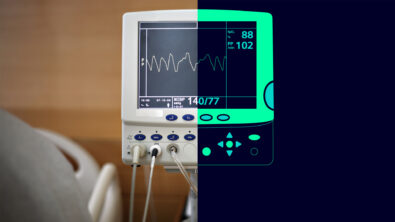Can your machines talk? How the Internet of Things is transforming medical device supply chains

You’re a medical device manufacturer on the cutting edge of innovation. You’ve developed a new lifesaving device, but getting it from production to patients is a constant scramble. Disruptions, delays and a lack of visibility plague your supply chain.
Sound familiar?
In today’s dynamic healthcare landscape, medical device companies are under pressure to rapidly adjust production and ensure seamless traceability, all while adhering to ever-changing regulations.
This is where the concept of an intelligent supply chain comes in – and it’s the future of medical device manufacturing. But what exactly is it, and how can it revolutionize your business?
Untangling your medical device supply chain
The COVID-19 pandemic exposed a harsh reality for medical device manufacturers: traditional planning systems simply couldn’t keep pace with a rapidly changing world. Disruptions became the norm and adapting production capacity felt like a guessing game.
The good news? We’re on the cusp of a revolution in medical device manufacturing, and it’s powered by the cloud.
With a cloud-based platform that seamlessly integrates all your production and logistics data, you’ll no longer deal with information silos or scrambling for updates. This platform, fueled by the Internet of Things (IoT), connects your machines to the entire supply chain. Machines talk to each other, sharing real-time data on production status. Logistics adapt automatically, ensuring on-time deliveries without a hitch.
This is the magic of an intelligent supply chain.
Here’s how the cloud and IoT work together:
• Real-time visibility: Production data is constantly fed into the cloud, allowing you to see exactly what’s happening on the factory floor. No more guesswork!
• Predictive planning: Anticipate changes in demand and adjust production capacity accordingly. This means you can avoid costly delays and ensure you have the devices you need, when you need them.
• Optimized logistics: With real-time production data, you can plan your logistics with pinpoint accuracy. No more overstocking or understocking – just efficient delivery, every time.
The benefits are clear: precise delivery times, reduced risk, and optimized resource allocation. This translates to a smoother operation, happier customers and a more competitive edge in the market.
Unleash the power of your medical devices
In the world of the intelligent supply chain, your machines aren’t just working, they’re communicating and every piece of equipment in your production line becomes a data source.
Gripper arms, conveyors, even individual components – they all share real-time information, creating a symphony of data that fuels a smarter, more efficient supply chain. This real-time information lets you monitor production lines with laser focus, predicting issues before they disrupt your flow.
Costly outages and missing parts are no longer a fact of life; IoT alerts you to potential problems like impending maintenance needs, allowing you to address them proactively.
And the entire system is capable of analyzing vast amounts of machine data which allows you to optimize production upstream and downstream, from initial orders to final delivery.
The resulting supply chain is predictive, automated and efficient.
But this isn’t just about efficiency – it’s about creating a smarter, more responsive supply chain that adapts to your needs. It’s the key to staying ahead of the curve in the competitive medical device market.
But how does it all come together? Let’s dive into a real-world example to explore how IoT and cloud technology create a truly intelligent supply chain.
From chaos to clarity: Dräger’s journey to efficient delivery
Dräger, a leading medical technology company, faced a challenge in consolidating production while ensuring efficient delivery. Their solution was to use an intelligent supply chain platform from Siemens Digital Logistics.
Dräger implemented a cloud-based system that automates their entire shipping process. This means no more manual booking or searching for carriers – the system finds the best option for each shipment and handles all the paperwork.
The company now has complete transparency in its inbound shipments. They can track the status of every delivery, ensuring a smooth flow of materials for production.
By automatically consolidating shipments, Dräger reduces costs and optimizes its logistics network. This win-win translates to faster deliveries and improved overall efficiency.
Dräger achieved seamless transparency through an intelligent supply chain solution. Their story is a powerful example of the impact this technology can have on efficiency and visibility. But the future of medical device supply chains goes beyond individual success stories.
A digital marketplace teeming with innovative tools and services, all designed to optimize your operations is exactly what’s on the horizon.
The future of medical device supply chains is here
Imagine a world where medical device orders are fulfilled not from stockpiles but produced on demand. The moment a customer clicks “purchase,” the manufacturing process springs into action. 3D printers whir to life, crafting the exact device needed. Logistics are automated, with seamless communication between machines, warehouses and carriers.
This isn’t science fiction – it’s the power of a next-generation medical device supply chain.
This intelligent approach goes beyond just speed. Predictive analytics anticipate potential issues before they arise, ensuring smooth operations and on-time deliveries.
This “instant gratification” approach isn’t just about speed – it’s about revolutionizing customer satisfaction in the medical device industry. But this is just the tip of the iceberg.
In an intelligent supply chain, a digital network fosters communication across all levels: machines talking to machines, people to machines, and people to each other. Sensors on machines collect real-time data on performance, while 3D printers churn out customized devices. But data alone isn’t enough. An intelligent cloud-based system analyzes this data, streamlining processes and automating tasks like scheduling and inventory management.
The true magic happens when Artificial Intelligence (AI) enters the picture. AI can analyze vast amounts of data, identifying patterns and trends. This allows it to predict future needs and even recommend optimal supply chain strategies.
Siemens’ Operational Excellence for Medical Devices is your path to building an intelligent supply chain, providing you with a cloud-based, AI-powered digital network that gives you a smarter, more responsive supply chain that minimizes waste and maximizes efficiency.
Operational Excellence for Medical Devices is your key to achieving a smarter, more responsive and future-proof supply chain. Let us be your partner in this journey.
Learn more about our solutions and how we can help you unlock the full potential of your medical device manufacturing operations.
Conclusion
The medical device industry is on the brink of a transformation. Traditional, reactive supply chains are no longer enough. The future lies in intelligent, data-driven systems that can adapt to changing demands and deliver life-saving devices faster and more efficiently.
As a medical device manufacturer, you have a crucial role to play. By embracing cloud-based platforms, IoT technology and AI, you can unlock the immense potential of an intelligent supply chain.
This isn’t just about technology – it’s about revolutionizing how you operate. Siemens’ Operational Excellence for Medical Devices is here to help you make that leap. Our suite of cloud-based solutions unlocks the power of an intelligent supply chain, giving you the tools and insights you need to thrive in the dynamic world of medical device manufacturing.
Contact us and take the first step towards a future-proof supply chain. Together, we can ensure life-saving devices reach the people who need them most when they need them most.
For further information about the intelligent supply chain for medical devices, download our white paper.
Comments
Leave a Reply
You must be logged in to post a comment.



Understand NURS FPX 4900 Assessment
The NURS FPX 4900 assessment are the cornerstone of your development as a nursing leader, focusing on the synthesis of your learning to tackle complex healthcare issues. Starting with NURS FPX 4900 Assessment 1, each evaluation tests your readiness to lead in the dynamic field of nursing. Need online assignment writing or help with psychology assignment? We offer resources to make each assessment manageable. https://experttutors.info/nurs-fpx4900-assessment-1/